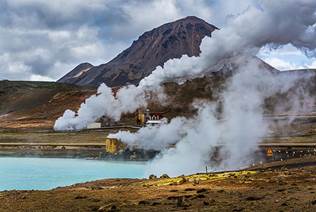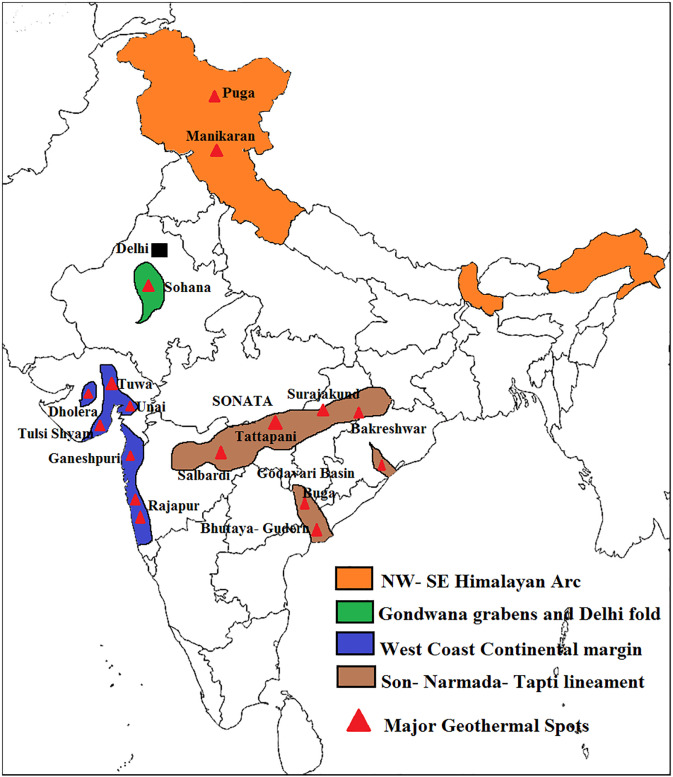Description

Disclaimer: Copyright infringement not intended.
Context
- ONGC has embarked upon a journey to generate electricity on a utility scale by tapping steam gushing from the earth at Puga, a remote valley located at an altitude of over 14,000 feet, off the road to Chumar on the de-facto border with China.
- ONGC last week started drilling its first well for the project and encountered high-pressure steam at 100 degrees Celsius with a discharge rate of 100 tonne geothermal energy per hour.
Details
- This will be India’s first geothermal energy project, and also the world’s highest. It will boost Ladakh’s potential to emerge as one of the country’s clean energy bowl by expanding the area’s horizon beyond solar or wind power.
Geothermal energy
- Geothermal energy is the thermal energy in the Earth's crust which originates from the formation of the planet and from The difference between the temperature in the earth’s core and the surface drives a continuous conduction of thermal energy from the centre to the exterior of the planet.
- High temperatures of over 4000°C cause some of the rock in the centre of the Earth to melt and form hot molten rocks called magma. These heats also cause the mantle to behave plastically and portions of it to convect upwards, since it is lighter than the surrounding rock.
- The rock and water in the Earth’s crust can reach heats of around 370°C.
- Thermal energy contained in the rocks and fluids can be found from shallow depths right down to several miles below the Earth’s surface. More recently geothermal power, the term used for generation of electricity from geothermal energy, has gained in importance.
Benefits of Geothermal Energy
- Renewable—Through proper reservoir management, the rate of energy extraction can be balanced with a reservoir's natural heat recharge rate.
- Baseload—Geothermal power plants produce electricity consistently, running 24 hours per day / 7 days per week, regardless of weather conditions.
- Domestic—Countries’ geothermal resources can be harnessed for power production without importing fuel.
- Small Footprint—Geothermal power plants are compact; using less land per GWh (404 m2) than coal (3642 m2) wind (1335 m2) or solar PV with center station (3237 m2).*
- Clean— It produces just one-sixth of the carbon dioxide emitted by a clean natural-gas power plant.
- Constantly available: Unlike other renewable energy sources, such as solar and wind, it is constantly available.
- Cheaper: Geothermal is also cheaper than conventional energy, with savings of as much as 80% compared with fossil fuels.
Governments across the globe are financially backing geothermal electric power generation through grants to stimulate sustainable form of energy.

Some Drawbacks of Geothermal Energy
- Firstly, production is limited to areas near tectonic plate boundaries. In addition, some locations may cool down after decades of use.
- Although it is cheaper than fossil fuels once a plant has been built, the drilling and exploration of these sites is expensive. This is in part due to the amount of wear experienced by drills and other tools in such aggressive environments.
- Geothermal plants can release hydrogen sulphide, a gas that smells like rotten eggs. Finally, some geothermal fluids contain low levels of toxic materials which need to be disposed of.
Geothermal provinces in India
- Geological Survey of India has identified about 340 geothermal hot springs in the country. Most of them are in the low surface temperature range from 37oC -90oC which is suitable for direct heat applications.
- These springs are grouped into seven geothermal provincese. Himalayan (Puga, Chhumathang), Sahara Valley, Cambay Basin, Son-Narmada-Tapi (SONATA) lineament belt, West Coast, Godavari basin and Mahanadi basin. Some of the prominent geothermal resources include Puga Valley and Chhumathang in Jammu and Kashmir, Manikaran in Himachal Pradesh, Jalgaon in Maharashtra and Tapovan in Uttarakhand. A new location of geothermal power energy has also been found in Tattapani in Chhattisgarh. In addition, Gujarat is set to tap geothermal electricity through resources which are available in Cambay between Narmada and Tapi river.
- Puga, which is located at a distance of about 180 km from Leh in the Ladakh region of Jammu and Kashmir across the great Himalayan range, is considered to be a good potential of geothermal energy. Although the Geological Survey of India (GSI) had discovered the Puga and Chumathang regions in eastern Ladakh as promising geothermal fields in India in the 1970s, development efforts by the government and private companies to exploit the energy did not materialize for some reasons,. Now ONGC has taken the initiative.
- According to the ministry of new and renewable energy, India has the potential to generate 10 gigawatt (GW) geothermal power.

Challenges to geothermal energy
- Production of geothermal electricity is very high and may require Rs 40 crore to produce 1 MW for a site that needs to be drilled more than 200 meters. Thus, India is still at nascent stage of geothermal energy utilization with no geothermal power plant set up in the country so far due to high upfront cost
- Though the cost of production is likely to decrease substantially with more projects being implemented, technology and equipment for such large-scale projects, which come from foreign countries, adds to the burden.
- Meanwhile, private initiatives in the field have been unsuccessful.
What will it take to unleash the potential?
- The government has failed to prioritize geothermal energy, unlike solar power. With the advantages becoming too obvious to ignore, scientists hope that the scenario may change down the line.
- Apart from Ladakh, there is abundant potential in Himachal Pradesh too which has several sources of geothermal energy along the rivers Alaknanda, Sutlej, Beas and Bhagirathi. The state government needs to focus on these sources to unlock the potential of geothermal energy.
- Industry led, applied R&D proposals to harness geothermal energy under Research, Design, Development & Demonstration (RDD&D) policy are necessary for this renewable energy source to become operational.. Plans should be made to develop Demonstration projects initially each for geothermal electricity production & direct heat use applications. PSUs may undertake resource assessment with support from leading countries as geothermal expert. Projects for space cooling and industrial process heating using GSHP technology may be supported through subsidy, preferential tariff from power companies as technology is energy/ water efficient.
https://timesofindia.indiatimes.com/business/india-business/ongc-readies-to-pump-geothermal-power-at-14000-feet-in-ladakh/articleshow/93695731.cms












